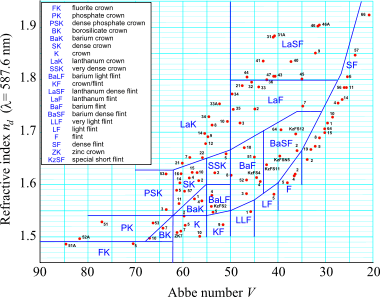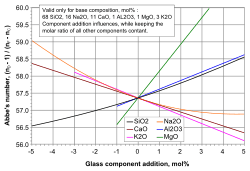Abbe number

In physics and optics, the Abbe number, also known as the V-number or constringence of a transparent material, is a measure of the material's dispersion (variation of refractive index with wavelength) in relation to the refractive index, with high values of V indicating low dispersion (low chromatic aberration). It is named after Ernst Abbe (1840–1905), the German physicist who defined it.
The Abbe number,[2][3] VD, of a material is defined as
where nD, nF and nC are the refractive indices of the material at the wavelengths of the Fraunhofer D-, F- and C- spectral lines (589.3 nm, 486.1 nm and 656.3 nm respectively).
Abbe numbers are used to classify glass and other optically transparent materials. For example, flint glass has V < 50 and crown glass has V > 50. Typical values of V range from around 20 for very dense flint glass, around 30 for polycarbonate plastics, and up to 65 for very light crown glass, and up to 85 for fluor-crown glass. Abbe numbers are only a useful measure of dispersion for visible light, and for other wavelengths, or for higher precision work, the group velocity dispersion (the full dispersion relation) is used.
Due to the difficulty and inconvenience in producing sodium and hydrogen lines, alternate definitions of the Abbe number are used in some contexts (ISO 7944).[4] The value Vd is given by
which defines the Abbe number with respect to the yellow Fraunhofer d (or D3) helium line at 587.5618 nm wavelength. It can also be defined using the green mercury E-line at 546.073 nm:
where F' and C' are the blue and red cadmium lines at 480.0 nm and 643.8 nm, respectively.
An Abbe diagram is produced by plotting the Abbe number Vd of a material versus its refractive index nd. Glasses can then be categorised by their composition and position on the diagram. This can be a letter-number code, as used in the Schott Glass catalogue, or a 6-digit glass code.
Abbe numbers are used to calculate the necessary focal lengths of achromatic doublet lenses to minimize chromatic aberration.
The following table lists standard wavelengths at which n is usually determined, indicated by subscripts.[5] For example, nD is measured at 589.3 nm:
| λ in nm | Fraunhofer's symbol | Light source | Color |
|---|---|---|---|
| 365.01 | i | Hg | UV |
| 404.66 | h | Hg | violet |
| 435.84 | g | Hg | blue |
| 479.99 | F' | Cd | blue |
| 486.13 | F | H | blue |
| 546.07 | e | Hg | green |
| 587.56 | d | He | yellow |
| 589.3 | D | Na | yellow |
| 643.85 | C' | Cd | red |
| 656.27 | C | H | red |
| 706.52 | r | He | red |
| 768.2 | A' | K | IR |
| 852.11 | s | Cs | IR |
| 1013.98 | t | Hg | IR |
See also
- Abbe prism
- Abbe refractometer
- Calculation of glass properties, including Abbe number
- Glass code
References
- ↑ Abbe number calculation of glasses
- ↑ Hovestadt, H. (1902). Jena Glass and Its Scientific and Industrial Applications. London: Macmillan and Co. pp. 1–81.
- ↑ Bergmann, Ludwig; Clemens Schaefer (1999). Optics of Waves and Particles. Berlin: Walter de Gruyter. pp. 198–201. ISBN 3-11-014318-6.
- ↑ Meister, Darryl. "Understanding Reference Wavelengths" (PDF). Carl Zeiss Vision. Retrieved 2013-03-13.
- ↑ L. D. Pye, V. D. Frechette, N. J. Kreidl: "Borate Glasses"; Plenum Press, New York, 1977



